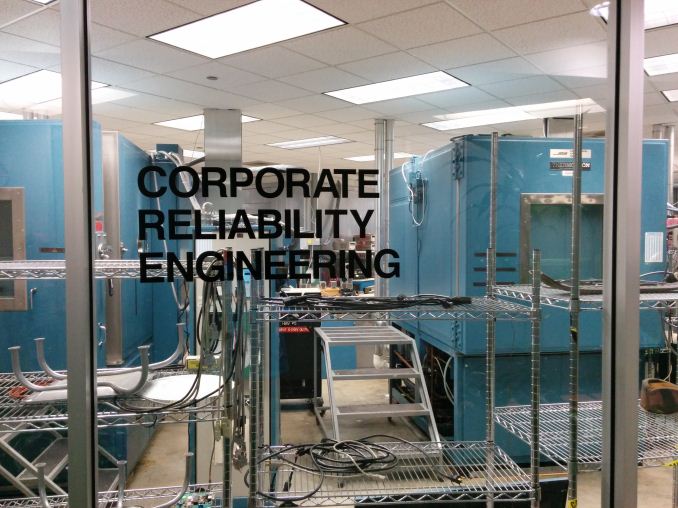HP Labs: the Science of Technology
by Jarred Walton on July 1, 2014 6:00 AM EST- Posted in
- IT Computing
- HP
- Mobile Workstation
- Laptops
- Enterprise
- server
- Tour

Welcome to HP's Houston Campus
Recently HP invited journalists from a variety of publications down to their Houston location for a tour of the Science Labs – facilities and labs dedicated to designing, testing, debugging, analyzing, and improving HP products. The groups we met with were largely tasked with improving commercial products, so the focus was more on business and enterprise products like workstations (desktop and mobile) and servers, and not so much on the consumer variants of these products. I'll admit that as this is the first time I've had a chance to go on a tour with any of the major OEMs, I didn't quite know what to expect. Needless to say, there were some cool demonstrations, a lot of interesting information, and a few experiences that were quite awesome.

Houston: Mountains Not Included
Just a few brief items of interest before we start with the tour, the HP campus in Houston is home to around 10,000 employees and contractors, and it was originally part of Compaq before the merger (or acquisition, depending on how you want to look at things). Of the 10,000 or so personnel at the Houston site, it's worth noting that only a small percentage (maybe 5%, give or take) are directly involved with the labs we toured on this visit. Other aspects of the Houston location include server assembly, research and development, administrative, marketing, customer experience, etc. – basically all the normal stuff you'd see at any large OEM location.
If you happen to follow me on Twitter, I actually decided to put the service to good use for a change and tweeted a bunch of photos throughout the day, so you were able to follow along. I have plenty of other photos along with a few videos to share, and today I'll discuss what we were shown and the nature of the testing and validation in much more detail than the short 140 character Twitter posts would allow. Plus I'm not wandering around the HP campus trying to type on my smartphone, which will certainly make writing easier.










15 Comments
View All Comments
blackmagnum - Tuesday, July 1, 2014 - link
Please consider whether the pictures should accompany their relevant paragraphs to give the article a more attractive reading layout?gostan - Tuesday, July 1, 2014 - link
This tour shows you why HP is struggling. Look at those products! And of all the clips in this world, they picked Meg Whitman's interview!!??aaronjgoodrich - Thursday, July 3, 2014 - link
Explain your comment please? I can guess why you responded like you had.. but I would not like to assume. I need to hear you out first.HardwareDufus - Tuesday, July 1, 2014 - link
These guys work in Little dungeons... tiny Little isolated cubes... it's difficult to interact with each other... They need to open those spaces up in the Multimedia Lab and Software Testing Lab..vLsL2VnDmWjoTByaVLxb - Tuesday, July 1, 2014 - link
I know the software validation ain't that great as I was stuck with an Elitebook 850 G1 for 6 months that could barely operate after hibernation/sleep. Called HP for support and they were useless.ftp://ftp.hp.com/pub/softpaq//sp66001-66500/sp6611... Is the issue/fix in detail, long after HP had told me again and again it was on my side. Kinda shameful I wasted so many hours on trying to fix that or that a bug that large actually exists. HP used to be such a great engineering company!
aaronjgoodrich - Thursday, July 3, 2014 - link
Wait, so a software fix which was readily available but not applied to your system is "HP's" engineering issue? I think that's a common sense issue there. No hardware was failing. It was a software issue. Plain as day from the link you provided. Maybe you hadn't applied all the hotfixes/patches to the system you were working on? "Synaptics TouchPad/ForcePad Driver " isn't a problem with engineering of hardware. Synaptics isn't HP. Think again.NikAwesome - Wednesday, July 9, 2014 - link
They should be responsible because they chose that part. The whole "experience" should be tested and guaranteed by HP because it is their product. They care about HW and SW, that's why Apple has an enormous satisfaction customer ratio (at the cost of being proprietary and not-open, they are control freaks)NikAwesome - Wednesday, July 9, 2014 - link
Edit: They should be responsible because they chose that part. The whole "experience" should be tested and guaranteed by HP because it is their product. They SHOULD care about HW and SW, that's why Apple has an enormous satisfaction customer ratio (at the cost of being proprietary and not-open, they are control freaks)vLsL2VnDmWjoTByaVLxb - Thursday, July 31, 2014 - link
The issue existed for 5 months. I was able to repeat it on other hardware. HP refused to look into it. That is a breakdown in engineering AND support."No hardware was failing. It was a software issue."
You do realize that HP encompasses both sides of the spectrum, right?
"Maybe you hadn't applied all the hotfixes/patches to the system you were working on?"
I had, of course. That is newb 101 tech stuff to try, dude.
""Synaptics TouchPad/ForcePad Driver " isn't a problem with engineering of hardware. Synaptics isn't HP. "
One wonders why HP would allow faulty software to come with their hardware? Dual edged sword. HP lost quite a bit of revenue based on their response to this one issue. Engineering (improper validation for basic functionality) and support (Customer couldn't possibly be right on this one) fail.
Samus - Tuesday, July 1, 2014 - link
Coming from the family Tandy 1000SL 8086, my Dad knew I needed a new PC, one to myself, and one day he came home with a Compaq Prolinea 4/25s. My first PC.After a SoundBlasterCD kit to add audio and CD-ROM, 8MB memory upgrade and a 500MB Maxtor hard drive to upgrade the 120GB Quantum, it had seem to reach its limits.
Until I got a 486/75MHz overdrive chip for my birthday.
And what was really facinating about this upgrade was a jumper on the motherboard that selected between 25MHz and 33MHz. Curiously, I moved it to 33MHz, and all the sudden, I had a 486/100MHz Overdrive (something the PC wasn't, on paper, capable of.)
My first "overclock" and on an OEM system. That was a great PC. Eventually I ran OS/2 Warp, then Windows 95. Around the time Windows 98 came out, I built my first PC with an ASUS motherboard and an AMD K5 chip, which I also mildly overclocked to 120MHz from 100MHz. It wouldn't run 133MHz without eventually freezing ;)
Good times. Ever since, I've been a big fan of Compaq "enterprise-grade" hardware, which today we know as HP Proliant servers, the best selling servers in the world. They're annoyingly proprietary with their drive rails, Softpaq drivers, and torx screws, but having owned a Prolinea 20 years ago, I've been used to that since.
I'm glad to know a lot of the engineers that evaluated my first PC are still at HP. Because I found it at my parents house a few years ago and fired it up, and it booted right to the Windows 95 desktop with Rise of the Triad, Warcraft 2, and Big Red Racing for good measure.